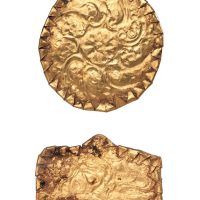Four gold ornaments
China, Jin dynasty, 265 - 420
A group of four gold ornaments, consisting of two circular and two rectangular pieces. The circular plaques are thin gold sheets, cut into a pattern formed by nine shaped petals radiating around a central stylised flower head. The nine petals are separated by tiny gold granular work and inset with small turquoise beads. The two rectangular plaques are decorated with very fine granular work. Each shows a winged human figure sitting astride a beast. The eye of the beast is inlaid with a turquoise bead. The decorations are reversed. All four gold sheets have triangular flaps at the back, which are folded over the rim.
These extremely fine gold plaques were possibly used as ornaments to be attached to clothing or to a hat. Mackenzie illustrates a similar plaque from a private collection and observes that the delicate style of granular gold work on this piece was introduced from Western Asia via the Steppes.[1] A comparable circular plaque with a “nine-petal whirlpool pattern” is in the collection of Simon Kwan in Hong Kong.[2] The same collection also contains a pair of rectangular gold plaques with a practically identical reversed decoration depicting a “winged man riding on a beast”.[3] A comparable granulated gold plaque with a man riding a beast, a turquoise bead forming the eye of the beast, dated to the late Han dynasty, is in the collection of Carl Kempe.[4]
- Mackenzie, C. From Diversity to Synthesis, Changing Roles of Metalwork and Decorative Style in China, article in Asian Art, the second Hali annual, Hali Publication Ltd., London, 1995, plate 30, p. 187
- Kwan, S. and Ji, S. Chinese Gold Ornaments, Muwen Tang Fine Arts Publication Ltd. Hong Kong, 2003, no. 138, pp. 282-3
- Kwan, S. and Ji, S. op. cit., no. 151, pp. 296-7
- Gyllensvärd, B. and others: Chinese Gold and Silver in the Carl Kempe Collection, The Museum of Art and Far Eastern Antiquities in Ulricehamn, 1999, no. 17, page 57


